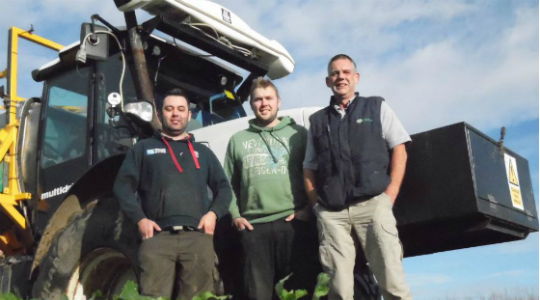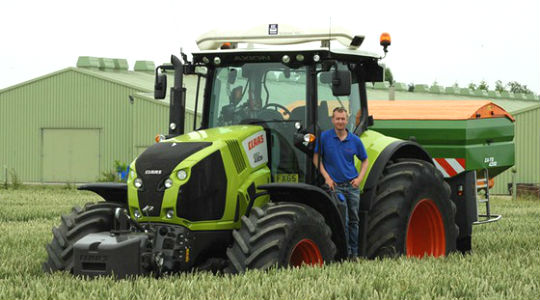N-Sensor transformed our business
Graham Porter from Naveby, Lincolnshire has used the N-Sensor for 10 years and is convinced it has transformed their business. "It would be very difficult to farm this variable land without an N-Sensor, the N-Sensor is a marvelous tool for us."
Whilst at Cereals 2017 Graham Porter with his son James visited the Yara stand where Chris Mason was discussing the N-Sensor and introducing it to prospective customers. In a short conversation with Graham and James, Graham emphatically told Chris that the N-Sensor had “transformed our business”.
To find out more Chris Mason from Precision Decisions Ltd, Yara's N-Sensor partners in the UK, suggested a visit to their operation would be very useful and less than a week later returned to Lincolnshire to meet with Tom Newton, the main operator of the N-Sensor and his father Ken.
Porters are well known for their animal feed products having manufactured feed for poultry and pigs for over 30 years. They run an extensive livestock operation which acts as a test facility for any ideas or technical developments designed to improve the performance or welfare of stock. A large arable farming business of 3000 acres complements the integrated approach adopted by the business.
Historic built-in variability
All this livestock produces a great amount of muck rich in nitrogen and for the last 30 years this chicken litter and pig muck has been liberally applied across their arable land, often as a first and second dressing. For the first 15 years or so the spreading of this FYM was contracted out and this often resulted in a very uneven application and built up additional spatial variability in the soils compounding the natural variability present from a wide variety of soil types. In-field soil types vary from light blown sands to heavy blue clays. Many years of this practice built up high residual nitrogen content and was only compounded by the blanket application of N throughout the growing season.
Extremely variable crop growth
Over the years these practices led to extremely variable crop growth. Particular problem areas being headlands and large areas where old muck heaps had been sat, along with fields local to the core farm. Not really having any accurate idea as to how much N was available to the plants along with the blanket application of N on dressings subsequent to the FYM dressings, led to the over application of N and subsequent problems associated with lodging and uneven crop growth in many areas.
Introduction of the Yara N-Sensor
In 2007 as the arable farm was growing in size through the acquisition of more land, Graham Porter after discussions with Clive Blacker of Precision Decisions decided that the farm needed to address these problems. They took muck spreading operations in house using their own Bunning spreaders and decided to lease their first N-Sensor the Passive model, continuing with this until 2015. It soon became apparent that the N-Sensor could deal with the extremely variable N levels within the crops in a far superior way to any ‘on the hoof’ manual control of the nitrogen rate from the spreader.
According to Chris Mason, "the passive N-Sensor in terms of its agronomic algorithms is virtually identical to the ALS (Automatic Light Source), but because it can only be used in ambient light conditions when the sun is higher than about 25 degrees above the horizon this results in a tight operating window in the early part of the year. On smaller farms with sufficient time this is not a problem, but for larger operations this can be quite a problem."
Yara developed and introduced the ALS N-Sensor in 2005 as a solution to restricted working hours due to low light levels. The Xenon light source within the ALS allows it to operate irrespective of ambient light conditions, even in complete darkness.
Introduction of the Yara N-Sensor
In 2007 as the arable farm was growing in size through the acquisition of more land, Graham Porter after discussions with Clive Blacker of Precision Decisions decided that the farm needed to address these problems. They took muck spreading operations in house using their own Bunning spreaders and decided to lease their first N-Sensor the Passive model, continuing with this until 2015. It soon became apparent that the N-Sensor could deal with the extremely variable N levels within the crops in a far superior way to any ‘on the hoof’ manual control of the nitrogen rate from the spreader.
According to Chris Mason, "the passive N-Sensor in terms of its agronomic algorithms is virtually identical to the ALS (Automatic Light Source), but because it can only be used in ambient light conditions when the sun is higher than about 25 degrees above the horizon this results in a tight operating window in the early part of the year. On smaller farms with sufficient time this is not a problem, but for larger operations this can be quite a problem."
Yara developed and introduced the ALS N-Sensor in 2005 as a solution to restricted working hours due to low light levels. The Xenon light source within the ALS allows it to operate irrespective of ambient light conditions, even in complete darkness.
A change to the ALS
In 2015 the Porters decided that the productive land had grown to such an area that the Passive N-Sensor was no longer suitable and upgraded to the ALS model. This gives the main operator Tom Newton unlimited application time.
Tom is a total convert to the N-Sensor and said that “It would be very difficult to farm this variable land without an N-Sensor, the N-Sensor is a Marvelous Tool for us” The N-Sensor is presently mounted on a Class Axion 850 with a new Amazone ZATS spreader spreading at 24m controlled by an Amatron 3. They prefer to spread their Urea at 24m as this fits well with their practice of spreading FYM at 12 or 24m. Tom feels that to spray their N from their Agrifac sprayer at 48m would be too wide a spread.
The typical rotation of crops is 1400ac of WW, 1000ac of OSR and 300ac each of WB and SB.
Last years (2016) reduced yield came in at around 5 t/Ha for OSR and around 12.5 t/Ha for WW. The figures for the better season of 2015, were 6.00 t/Ha (OSR) and 14.3t/Ha (WW) with Spring Barley returning 9 – 10 t/Ha, “A wonderful yield” according to Tom.
Overall the Porters and Tom Newton are convinced that the N-Sensor along with the application of growth regulators, has increased yields in poor areas whilst holding back the more fertile areas, therefore ironing out variation and massively reducing lodging, which leads to a much improved combining process at the end of the season.
Text and Photos: Chris Mason, Precision Decisions Ltd.
Related tools
Related articles























































